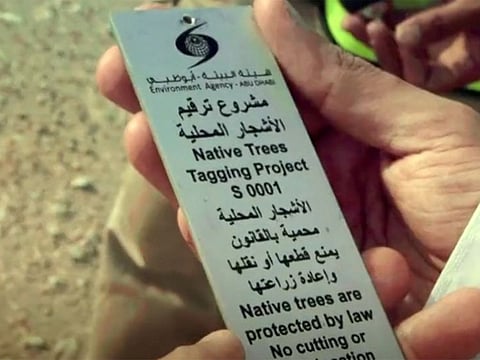Watch: How Abu Dhabi tags and monitors old native trees to ensure their protection
First phase to focus on Ghaf trees and Jebel Hafeet National Park’s Samar trees

Abu Dhabi: An ambitious project in Abu Dhabi will now locate, number and specifically monitor old trees in the emirate in a bid to ensure their protection from threats.
About 100,000 Ghaf (Prosopis cineraria) and Samar (Acacia ehrenbergiana) trees — both locally important yet threatened species — are known to grow in the emirate and these will be identified and tagged during the Environment Agency — Abu Dhabi (EAD) project.
Each tree will be marked with an identification tag, which will bear serial numbers classified according to the tree type. The tree will also be electronically numbered via serial codes linked to geographical databases.
“This project aims to tag old Ghaf and Samar trees of important environmental and heritage values. EAD has begun to implement the programme by identifying the targeted tree species using satellite and aerial images and then storing the coordinates for each tree in a database. This is followed by the actual numbering of the historical trees,” said Dr Shaikha Al Dhaheri, the EAD secretary-general.
Traditionally, families in the desert tend to settle under the shade of Samar trees. These trees also include soil preservation benefits.
First phase
The programme has started from the Jebel Hafeet National Park, a mountainous protected area in Al Ain city. The EAD had earlier implemented a project to rehabilitate Samar trees in the park affected by climate change, illegal human activities and development projects.
In the first phase, 1,500 Samar trees in the Jebel Hafeet park will be tagged with specially designed metal panels or identification tags, along with 1,500 Ghaf trees across the emirate by the end of the year. Trees in Abu Dhabi city and Al Dhafra will be tagged in future phases.
Through this project, the EAD aims to protect local trees from illegal activities and also to enhance the quality of available data on local trees in natural habitats. A detailed assessment of the condition of each tree will therefore be recorded, along with other morphological information that will further help in assessing the trees’ resilience in combating desertification to mitigate climate change.
Protecting natural heritage
“The numbering of historical trees is one of the main pillars from which EAD will launch a long-term protection plan for local trees in Abu Dhabi, which will then ensure their sustainability,” said Ahmed Al Hashmi, the EAD acting executive director for terrestrial and marine biodiversity.
The official explained that natural Ghaf and Samar trees are an important component of the UAE’s plant biodiversity, as these two species have been classified among the threatened plant species of Abu Dhabi.
Maping trees
The EAD has already prepared detailed maps of the spread of both Ghaf and Samar trees in the emirate of Abu Dhabi — a first-of-its-kind initiative in the UAE — and has documented the distribution of all Ghaf and Samar trees using satellite image analysis, Al Hashmi added. The authorities have additionally tested soil salinity and groundwater availability in relation to each tree.
Analysing the recorded information will help EAD understand the environmental requirements of the species and determine the extent of the dangers they are exposed to — whether due to human, natural or climatic activities. This can help tailor protection activities for the trees.
Tailoring development
EAD will also share maps of the trees and their distribution with various partners so that their protection can be taken into consideration when designing development projects.
Regulatory protection
Local trees in the UAE are protected under Federal Law No (24) of 1999. The regulation stipulates that these trees should not be felled; if necessary, it is obligatory that the trees be transported and replanted. One of the main threats to these species, including to Abu Dhabi’s Ghaf and Samar trees, is habitat loss and degradation. Other threats include the collection of wood for use as camping fuel, urban development, increased infrastructure, overgrazing and climate change.
The EAD works extensively to protect native plants and has mapped their growth across the emirate. In addition, it manages a nursery in Al Dhafra region with more than 60 types of local plant species. The nursery can produce 500,000 seedlings annually for use in habitat rehabilitation projects.
The EAD also monitors 432 native plant species and has classified them according to their threat level, based on the International Union for Conservation of Nature.
In addition, the authority now oversees 19 protected areas in Abu Dhabi, with 17 per cent of the emirate’s terrestrial area represented in 13 protected sites.
Sign up for the Daily Briefing
Get the latest news and updates straight to your inbox







